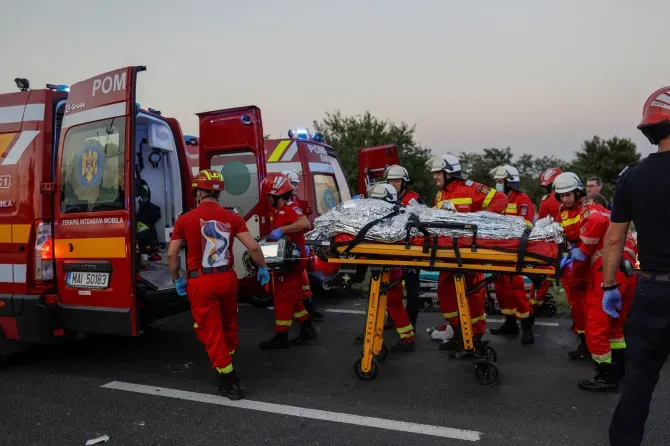Understanding the Impact of a Recent Massive Explosion in Romania
A heart-wrenching incident unfolded at a liquefied petroleum gas (LPG) station in Romania, where a series of explosions rocked the premises.

Introduction
Romania's energy sector has undergone significant transformations in recent years, with a growing emphasis on diversification and sustainability. One key player in this evolution is natural gas, a versatile and relatively cleaner fossil fuel than coal and oil. In this blog post, we will delve into the role of natural gas in Romania's energy mix, examining the opportunities it presents and the challenges that must be addressed for a balanced and resilient energy future.
The Incident
A heart-wrenching incident unfolded at a liquefied petroleum gas (LPG) station in Romania, where a series of explosions rocked the premises. Tragically, these explosions claimed the life of one individual and left 46 others injured. Among the wounded were 26 brave firefighters who had rushed to the scene following the initial explosion in close proximity to the capital city of Bucharest on a fateful Saturday evening. The shockwaves from the first blast were quickly succeeded by a second eruption, creating a haunting mushroom cloud that loomed over the forecourt located in Crevedia. Of the injured, at least eight individuals suffered severe burns, prompting authorities to arrange for the transfer of four patients to overseas medical facilities. The severity of the situation led to the evacuation of individuals within a 700-meter radius of the site.

Raed Arafat, the eminent figure at the helm of Romania's emergency department, has underscored the ongoing peril in the area, cautioning that the risk of another explosion looms, particularly involving another tanker. Romania's President, Klaus Iohannis, expressed his profound sorrow, labeling the explosions as a 'tragedy' that has deeply saddened him. He swiftly called for a thorough investigation into the incident, seeking to determine if any regulations had been breached. Urgent actions were also sought to support the injured and to preempt any recurrence of such heartrending incidents.
Impact on the Community
The profound repercussions of the explosion at the liquefied petroleum gas (LPG) station in Romania resonated deeply within the local community. Tragically, one life was lost, and a staggering 46 individuals sustained injuries, among them 26 valiant firefighters who swiftly responded to the initial explosion. The gravity of the situation is underscored by the fact that a minimum of eight of the wounded suffered severe burns, compelling authorities to arrange for the transfer of four of them to medical facilities abroad. This dire situation prompted the evacuation of individuals residing within a 700-meter radius—approximately half a mile—from the site, a preventive measure in response to the potential threat of another explosion.
The incident's gravity was echoed by Romania's President, Klaus Iohannis, who referred to it as a 'tragedy'. President Iohannis urgently called for a comprehensive investigation to determine if any regulations were violated. He also implored authorities to take swift action to support the injured and implement measures to avert any recurrence of such heartrending incidents.
The far-reaching impact of such occurrences on the community cannot be understated, encompassing emotional trauma, property loss, and disruption of daily life. The imperative for authorities lies in providing unwavering support and assistance to those affected while simultaneously redoubling efforts to prevent the reoccurrence of similar tragedies in the future
Root Causes and Investigations
Preliminary accounts suggest that a fire erupted at the fueling station, leading to two consecutive explosions that resulted in one fatality and numerous injuries. The calamitous event unfolded at a fueling facility that dispenses LPG—a versatile fuel used in household appliances and as an alternative to gasoline and diesel for specific vehicles. The incident transpired within the confines of Crevedia, a town situated approximately 30 kilometers (18 miles) to the northwest of Bucharest, the capital of Romania.

Prompted by the magnitude of the situation, Romania's President, Klaus Iohannis, has appealed for a swift commencement of an investigation to ascertain any potential breaches of regulations. He also issued an urgent plea to authorities, urging the prompt implementation of measures to assist the injured.
FAQs
What is the explosion range of LPG?
The lower flammability limit (LFL) is found to be 1.81% and the upper flammability limit (UFL) is 8.86% of LPG for upward propagation of flame.
What are the risks of LPG gas?
LPG vapors can run for long distances along the ground and can collect in drains or basements. When the gas meets a source of ignition it can burn or explode.
Which gas is maximum in LPG?
LPG is either 100% propane, 60% propane and 40% butane, or 35% propane and 65% butane.
Rapid and Comprehensive Emergency Response to LPG Station Explosion in Romania
The emergency response following the explosion at the liquefied petroleum gas (LPG) station in Romania unfolded with remarkable speed and thoroughness. Swift action was taken by emergency crews in the wake of multiple explosions and a subsequent fire outbreak at the LPG station, situated alongside National Road A within Crevedia, Dambovita County. This unsettling incident, coupled with the coordinated emergency response, prompted the closure of traffic along National Road 1A, with an additional measure of evacuating individuals residing within a 300-meter radius (approximately 984 feet) of the incident site.
The fire's outbreak was accompanied by the release of a substantial volume of smoke, potentially impacting the air quality within the vicinity in the hours to follow. Recognizing this concern, authorities issued advisories, urging people to steer clear of the incident site until the fire was fully extinguished and an official all-clear was communicated. They further recommended opting for alternative routes to navigate around the affected area, thus mitigating potential disruptions. Additionally, individuals were strongly advised to adhere to directives issued by local officials, including evacuation mandates, and to stay indoors if heavy smoke enveloped their immediate surroundings.
Drawing Lessons from the LPG Station Explosion in Romania
The explosion at the liquefied petroleum gas (LPG) station in Romania underscores the critical importance of gleaning insights from such events and taking proactive steps to avert similar tragedies. Authorities have taken swift action by launching an investigation to ascertain the root cause of the incident and to uncover any potential oversights or breaches in safety protocols.
To pave the way for a safer future, it becomes imperative for authorities to engage in a comprehensive reevaluation of safety regulations and protocols, particularly for LPG stations and other facilities deemed hazardous. This encompassing approach might encompass periodic safety audits, equipping personnel with proper training and resources, and enforcing stringent safety measures to forestall any untoward incidents.
Furthermore, it remains paramount for authorities to extend unwavering support and assistance to those impacted by the calamity, spanning from medical aid and financial aid to crucial emotional support. In parallel, the community can contribute significantly by fostering safety consciousness and advocating for the implementation of rigorous safety regulations that fortify the foundation of security for all.
Conclusion
The massive explosion in Romania has shaken the nation to its core, prompting introspection, solidarity, and a commitment to resilience. As investigations continue, the incident serves as a somber reminder of the critical need for stringent safety measures and proactive disaster preparedness. Through collaboration, empathy, and a determination to learn from this tragedy, Romania can pave the way for a safer, more secure future for all its citizens.




